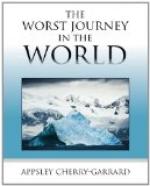“The absence of papillae below the tarsal joint in Emperor embryos, together with the fact that in many birds each large feather papilla is accompanied by two or more very small feather papillae, led me to study the papillae of the limbs of other birds. The most striking results were obtained from the embryos of Chinese geese in which the legs are relatively longer than in penguins. In a 13-days goose embryo the whole of the skin below and for some distance above the tarsal joint is quite smooth, whereas the skin of the rest of the leg is studded with feather papillae. On the other hand, in an 18-days goose embryo in which the feather papillae of the legs have developed into filaments, each containing a fairly well-formed feather, scale papillae occur not only on the foot below and for some distance above the tarsal joint but also between the roots of the feather filaments between the tarsal and the knee joints. More important still, in a 20-days goose embryo a number of the papillae situated between the feather filaments of the leg were actually developing into scales each of which overlapped the root (calamus) of a feather just as scales overlap the foot feathers in grouse and other feather-footed birds.
“As in bird embryos there is no evidence that feather papillae ever develop into scales or that scale papillae ever develop into feathers it may be assumed that feather papillae are fundamentally different from scale papillae, the difference presumably being due to the presence of special factors in the germ-plasm. Just as in armadillos hairs are found emerging from under the scales, in ancient birds as in the feet of some modern birds the coat probably consisted of both feathers and scales. But in course of time, owing perhaps to the growth of the scales being arrested, the coat of the birds, instead of consisting throughout of well-developed scales and small inconspicuous feathers, was almost entirely made up of a countless number of downy feathers, well-developed scales only persisting below the tarsal joint.
“If the conclusions arrived at with the help of the Emperor Penguin embryos about the origin of feathers are justified, the worst journey in the world in the interest of science was not made in vain.”
* * * * *
END OF VOLUME ONE
Printed in Great Britain by R. & R. CLARK, LIMITED, Edinburgh.
[Illustration: A HALO ROUND THE MOON—E. A. Wilson, del.]
THE WORST JOURNEY
IN THE WORLD
ANTARCTIC
1910-1913
BY
APSLEY CHERRY-GARRARD
WITH PANORAMAS, MAPS, AND ILLUSTRATIONS BY THE LATE
DOCTOR EDWARD A. WILSON AND OTHER MEMBERS OF THE EXPEDITION




